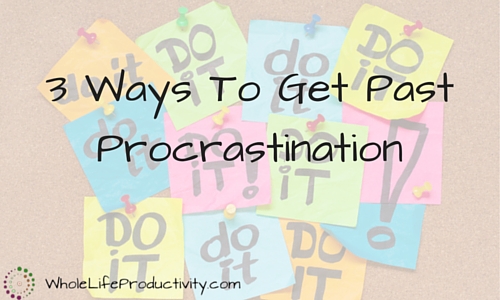
3 Ways To Get Past Procrastination
Why is it that we find it so hard to get going on things that need to be done?
I’m just back from yet another week-long trip. That makes it 3 out of 5 weeks of summer vacation I have been gone. Not a great set up for productivity.
Besides having my days all mixed up, I am also struggling with another silent foe: procrastination.
I knew that I needed to write this article, so I sat down at my computer. And 2 hours later I have barely started writing. On the other hand, I have parsed 26 recipes from my old software into the new, researched bathroom accessories for the new camper, looked through an online catalog, tried to find replacement covers for my planner, and set up click-through calendars for the new blog-writing software.
If it wasn’t nearly 100 degrees out, I would throw my hands into the air and run away screaming.
The reason I procrastinated? It wasn’t easy to start.
Why Easy Is Better
Having things easy means that you don’t have to try hard to get started.
We can make up all sorts of reasons why we can’t do something… “I can’t weed the garden because I can’t find the bags.” “I can’t pay the bills because I don’t have stamps.” “I can’t clean the toilet because the cleaner is all the way in the other room.” “I didn’t outline the last section of the paper, and I don’t know what to write.” “I forgot to thaw the chicken, so I can’t make the dinner I planned.” “It’s going to take much longer than I have.” “I only have 30 minutes, that isn’t enough time.”
If we can eliminate these reasons ahead of time, we have eliminated one barrier to productivity.
Making Things Easier
So let’s take a look at how we can make things easier.
1. Setting Things Up
Setting things up means that you have all the materials where you need them. This may mean keeping all the items needed for a task in one place.
Keep the bags and gloves and shears in a basket so you can grab it and start weeding. Keep a roll of stamps on hand next to your checkbook to make bill paying easy. Keep toilet cleaner and a brush next to each toilet.
When you have all things at hand, you are more likely to start the task, because you don’t have to do anything before to get the task going.
2. Making A Checklist
If you have a task that has steps that are to be done in order, a checklist can help make sure you don’t skip a step. This may mean having to write more things down, but will save forgotten steps.
Outline the paper so you can write a section at a time, knowing what you need to write. Make a checklist for dinner prep that involves thawing and other prep work so that you can simply throw dinner together.
When you use a checklist, you can eliminate stoppages due to not knowing what comes next.
3. Using A Timer
Timers can get you up and running, and also keep you from running over. Timers are all about fooling your mind. You can tell yourself that you will do a task for a certain amount of time, and get whatever you can done. This is better than nothing, and you will be surprised at how much can be accomplished in even 15 minutes!
Set the timer for 15 minutes and start. You might not finish, but you will make progress…and you may want to keep going. If you have only 30 minutes, set the timer and do what you can without watching the clock.
Timers eliminate the need to watch the clock, and this can free you from time-based procrastination.
4. All Of The Above
Of course, all of the above techniques can be used together. There are tasks that require the big guns for procrastination busting, after all.
Spend no more than a minute and see what your excuses are. Then use the technique(s) appropriate. It might be one. It might be all three.
Discussion Question
Think about the last time you just couldn’t get started on something. Why was it so hard? What did you do to finally break through?
Image by hang_in_there. Licensed under Creative Commons. Text added.



